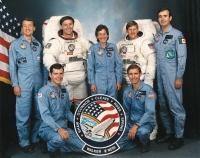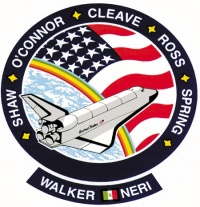STS-61B
From The Space Library
 | |
| Organization | NASA-Office of Space Flight (United States) |
|---|---|
| Mission type | Human Crew,Life Science,Microgravity |
| Launch date | November 27, 1985 |
| Launch vehicle | Space Shuttle |
| Launch site | Cape Canaveral, United States |
| COSPAR ID | 1985-109A |
| Inclination | 28.45 degrees |
| Experiments | Here |
| Alternate Names | STS 23,16273 |
| Additional Information | Here |
| Data Collection | Here |
| Payload Mass Up | 21762 kg |
| Payload Mass Down | 9301.82 kg |
| Orbiter | Atlantis |
| Lift Off Mass | 2,052,059.09 kg |
| Orbiter Weight at Liftoff | 118,913.64 kg |
| Orbiter Weight at Landing | 93,514.55 kg |
| Landed | Concrete runway 22 at Edwards Air Force Base, Calif. |
| Orbits of Earth | 108 |
| Orbital Altitude | 190 nautical miles (218 statute miles) |
Contents |
[edit] Crew
- Commander: Brewster A. Shaw
- Pilot: Bryan D. O'Conner
- Payload Commander:
- Mission Specialist 1: Sherwood C. Spring
- Mission Specialist 2: Mary L. Cleave
- Mission Specialist 3: Jerry L. Ross
- Mission Specialist 4:
- Mission Specialist 5:
- Payload Specialist 1: Charles D. Walker (as industrial payload specialist representing McDonnell Douglas Corp.)
- Payload Specialist 2: Rodolfo Neri Vela (Mexico)
ISS/Mir Crew Transport
[edit] Mission
STS 61-B was the second flight of the shuttle Atlantis. On board were Brewster Shaw, Bryan O'Conner, Mary Cleave, Sherwood Spring, Jerry Ross, Rudolfo Neri Vela (Mexico), and Charles Walker. Deployed during this mission were the Morelos-B (Mexico), Aussat-2 (Australian), and SATCOM KU-2 (RCA) satellites. This mission demonstrated construction in space by manually assembling the EASE and ACCESS experiments. Experiments required two space walks by Spring and Ross lasting five hours, 32 minutes, and six hours, 38 minutes, respectively. Middeck payloads included: Continuous Flow Electrophoresis System (CFES); Diffusive Mixing of Organic Solutions (DMOS); Morelos Payload Specialist Experiments (MPSE) and Orbiter Experiments (OEX). In the payload bay were the Get Away Special and IMAX Cargo Bay Camera (ICBC). Also deployed was the Station Keeping Target (OEX) to conduct advanced station keeping tests. The mission duration was 165 hours 4 minutes 49 seconds.
[edit] EVA
Extravehicular Activity (EVA) conducted by Jerry Ross and Sherwood Spring during two spacewalks for a total of 12 hours, 20 minutes. EVA 1, 5 hours, 34 minutes; EVA 2, 6 hours, 46 minutes.
[edit] Payload
Deploy SATCOM (RCA-Satellite Communications) Ku-2 with Payload Assist Module (PAM)-D II; deploy Morelos (Mexico communications satellite)-B with PAM-D; deploy AUSSAT (Australian communications satellite)-2 with PAM-D; EASE/ACCESS (Assembly of Structures - Assembly Concept for Construction of Erectable Space Structures) by extravehicular activity (EVA) astronauts; Continuous Flow Electrophoresis System (CFES); Diffusive Mixing of Organic Solutions (DMOS); IMAX camera; one getaway special (GAS); Linhof camera and Hasseblad camera
[edit] Books about the Space Shuttle Program
Buy This Book Click here |
Buy This Book here |
Buy This Book Click here |
Buy This Book Click here |





